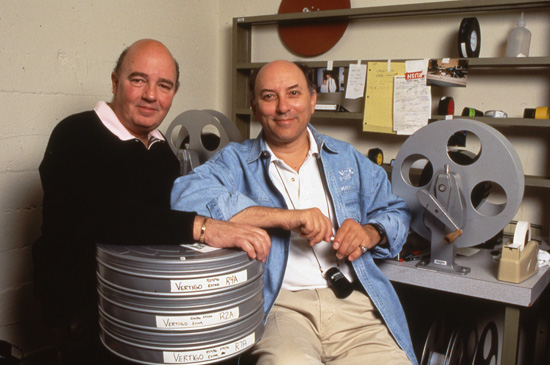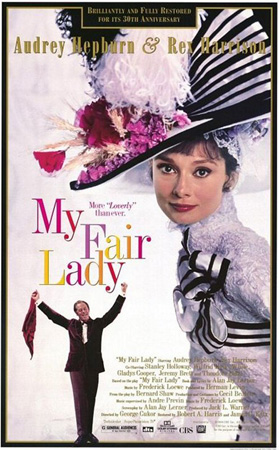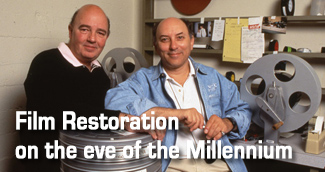Film Restoration on the eve of the Millennium | This article first appeared in |
Written by: Robert A. Harris & James C. Katz | Issue 59 - December 1999 |
 Robert Harris (right) and James Katz (left) with 70mm cans for "Vertigo". Image source: Robert Harris. Picture credit: Laura Luongo Robert Harris (right) and James Katz (left) with 70mm cans for "Vertigo". Image source: Robert Harris. Picture credit: Laura LuongoOver the past twenty years or so, film restoration has come out of the laboratory and into the theatres. It has become a concept that enables entities like The American Film Institute and The Film Foundation to bring in public funds to help preserve and restore our national film heritage. Films restored have run the gamut from the earliest works of cinema to the films of Griffith, Gance and their contemporaries - to the late silent and early sound era - and on to the Technicolor period and beyond. Each era and type of film carries with it its own set of difficulties challenges. The basics of film restoration, not unique to any era involve the gathering of all elements worldwide for the film to be restored or reconstructed, as well as all production and post production paperwork extant. From that point on, the differing film elements and era go in a myriad of different directions - creating a situation in which an archivist might well be advised to stay with a certain era or type of filmmaking. What we consider "real restorations" or "reconstructions" of note during the period have been Kevin Brownlow's work on Abel Gance's 1927 "Napoleon", Ron Haver's reconstruction of George Cukor's 1954 "A Star is Born", Bob Gitt's (for UCLA) three strip reconstruction/restoration of the first three strip Technicolor feature "Becky Sharp" as well as his work on John Ford's Technicolor "She Wore a Yellow Ribbon" and more recently Frank Capra's "Lost Horizon". Added most recently to the list are Frank Capra's "Matinee Idol" from The Academy of Motion Picture Arts & Sciences and Columbia Pictures, "In the Heat of the Night" again from the Academy and MGM. | Further in 70mm reading:
|
 1994 re-release poster for "My Fair Lady" 1994 re-release poster for "My Fair Lady"Our own work on films such as "Lawrence of Arabia", "Spartacus", "My Fair Lady", "Vertigo" and "Rear Window" holds us very much in the fifties and sixties. However, the films listed above don't even make a dent in the problem of film survival. There's a wonderful line in John Ford's "The Man Who Shot Liberty Valence" which states something like... "When truth becomes legend, print the legend." Unfortunately, the survival of our film heritage and just how much is being done within the studio system is, in some cases more legend than fact. And things don't bode well for our film heritage. Equally important to actual films being "restored," are the plethora of concepts, definitions and ill-researched journalistic reports about where we are and precisely what film "restoration" is all about. If one were to believe the press, there have been dozens of brilliant film restorations in the past few years alone. Add to this various "video" or "restored for video" works which further muddy the waters. All of this confusion - much of it industry-bred and manufactured to either sell tickets to supposed restored films or sell videos or DVDs, does nothing more than stall actual film restoration at best - and lead to destruction of the films in question at worst. While some studios do a perfectly professional job of archiving, preserving and restoring their assets, others - not to be left off the bandwagon - have taken an almost "Wag the Dog" position. While maintaining that all is well in Mudville, and taking great pride in their work, they point a finger squarely in the direction of the "real" restoration problem - "Orphan Films." ("Orphan Films" are films which have been located in recent years. They come from various sources, including university and private collections, and even commercial film vaults. There are many types of these films, including everything from silent films to newsreels to independent films, both old and new. However, they all suffer from the "defect" that there is no current clear copyright holder (other than the holder of the print or negative). And there are usually no funds, public or private, to make protection copies of the film or to do restoration or to make preservation materials. And unfortunately, unless there is some perceived financial gain from funding a re-print, these films are left to decay. --ed). | |
 70mm frame from "Napoleon". 70mm frame from "Napoleon".An interesting stance has become the "everything here's under control and we want to help so here's a contribution toward..." While the legitimacy of real Orphan Films need not be questioned, and while funding to preserve these films is of great importance, the reality of the situation is that in many cases important Studio Films are in worse condition than the Orphan Films. Within the video-driven film preservation/restoration scenario, major feature films will be left to rot as long as a video colorist can get an acceptable transfer of an extant fading film element. If one can either spend $30,000 to $1,000,000 or more to save a 35mm or large format (35mm eight perforation or 65mm film), and actually create elements which will save the film for centuries to come and either break even or make a small profit on their home videos, too many decisions are being made to go with "adequate" for DVD. The need for immediate gratification comes to the fore. Too many times, a beautiful - or at least nice - video is delivered to the unsuspecting public, on occasion using the original negative as a transfer element, thereby resigning the original negative to a worse fate than it would have suffered had it remained locked away, undisturbed, unpreserved, unrestored and untransferred. | |
 1989 re-release poster for "Lawrence of Arabia" 1989 re-release poster for "Lawrence of Arabia"Films "restored" for video or theatrical, while the original film elements may molder include non-orphans: "The King & I", "The Alamo", , "North by Northwest", "El Cid", "The Graduate", "Gone with the Wind", "The Godfather" and "Dr. Zhivago". We have an industry which cannot agree what "Film Restoration" actually is. We have, bright and generally responsible journalists who can be swayed into belief by well-written studio handouts. We have a public which innocently views the latest DVD and makes the assumption that "the film" actually still exists as film and is in some way conserved. We are very much in that same position taken a quarter of a century ago when nitrate studio negatives were copied onto unstable stock and then dumped unceremoniously into the Pacific or used as landfill. And the executives who make these decisions? Within eighteen to twenty-four months they're at another studio, or another higher paying position in broadcast, video or anywhere else, where they can make more astonishingly uninformed decisions, the results of which won't come to light until after they've left the company. With studios being consumed and traded like really expensive baseball cards; with libraries being broken up, sold, structured and restructured; it has become a virtual impossibility for some entities to properly conserve, preserve and restore on any rational basis. With an impossibly large number of titles (read: film elements) coming of age in the year 2000, we are dealing with more faded, shrunken and decomposing rolls of acetate, containing both picture and sound, than most people can imagine. I'll repeat myself. Some studios are doing a superb job of saving and conserving their assets. For others, and many great films, its almost after the end. "Lawrence of Arabia", perhaps the world's most famous 70mm film. Restored by Robert A. Harris and re-released February 4, 1989 (at the Ziegfeld in New York) to great acclaim. The film world premiered at the Odeon Leicester Sq. in London, England on December 10, 1962 and was later cut from 222 minutes to 187 minutes. The restored and reconstructed director approved version runs 218 minutes. | |
 • Go to Film Restoration on the eve of the Millennium | |
| Go: back - top - back issues Updated 15-04-24 |
